Robert Yang (楊劍鵬) is a man who names authentic Tyrannosaurus Rex fossils after himself, creates “Secret Invasion School Bio-informatic” art, has sperm-shaped lights over his bed and tells people that he has the “best things in Taiwan” at Robert Y Ruins, his “3D virtual art museum with new thoughts and crazy dreams” in Yilan County’s Suao Township (蘇澳).
But that is only the surface — and probably just a small part of it. It is hard to figure out Yang by just spending an afternoon with him. But he’s not just all talk. His museum, an epic project only about halfway complete, is well worth the visit.
Located in a three-story abandoned frozen food factory surrounded by lush farmland, it contains room after room of Yang’s own creations and an extensive collection of early works by renowned Chinese sculptor Qiu Qijing (邱啟敬). Yang says he met Qiu many years ago when he was still an unknown, deciding to support and “cultivate” his talent as well as exchange ideas, which eventually led to his own creations.
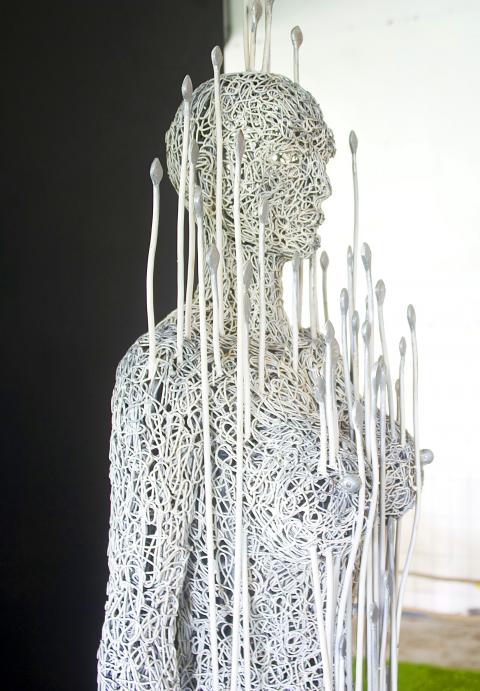
Photo: Han Cheung, Taipei Times
Yang considers himself more of a creative director — he has a team of craftspeople in China’s Xiamen and he also collaborates with Clitfford Kong (孔雷明). One piece he likes to tell people about is the Thirty-thousand Year Erection (勃起三萬年), which consists of a one-tonne Brazilian geode elevated about 1m off the ground.
“This stone is the human heart,” Yang says. “If we consolidate the energy that our heart uses to beat for one whole day, it can lift up this stone this high. This piece should be displayed in a hospital.”
Almost all of the furniture, decorations and art in the museum are made of wood retrieved from sunken ships — even the bathroom sink. The most impressive piece is a 2-ton, 10m-long table made from a single piece of wood, which he culled from a ship. The object is located on the roof, where Yang hopes to host gatherings and events. The place will open to the public, Yang says, hopefully within a year.
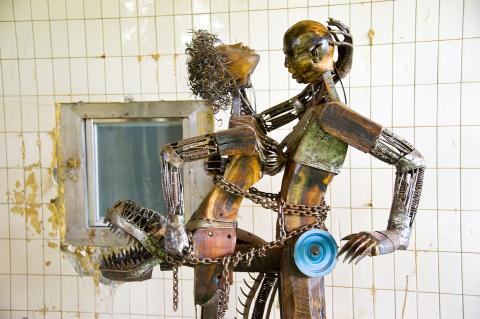
Photo: Han Cheung, Taipei Times
ROBERT Y AND ROBERT YANG
It was impossible to ignore Yang’s display at April’s Creative Expo. Unlike most of the chic, minimalistic exhibits, Yang’s was bold, raw and loud, located right at the entrance of one of the halls featuring a bright-green, faux-grass carpet backed by an amethyst-studded wall, punctuated by a muscular dinosaur with a raised fist, the words “ROBERT Y” in red running across its chest and up its arm.
In addition to his creations, Yang will tell visitors about his real Tyrannosaurus Rex fossils (obtained legally from the US, he says). He named the first skeleton Robert Y, but he then says he has something 100 times better as he displays photos of a fossilized T-Rex head with a smaller dinosaur in its mouth.
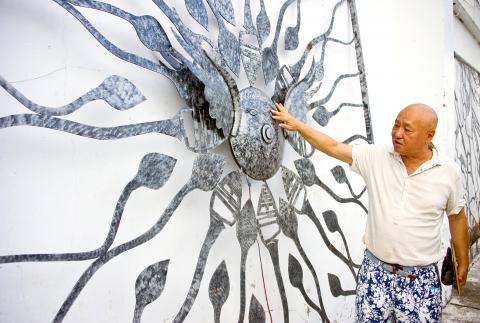
Photo: Han Cheung, Taipei Times
“This one is called Robert Yang,” he says. “Robert Yang ate another dinosaur some billion years ago.”
When asked about his fascination with dinosaurs, Yang simply says, “They are able to satisfy my curiosity. That’s something very important in life.”
Finally, there are two copulating dinosaur fossils (dubbed Robert Y and Susan) in one of the rooms. “It’s a secret,” he says when asked if they are real or not.
Secrets, indeed. Yang does not seem to be keen to talk facts. He says he is turning 40 in 20 years when asked his age. He even shrouds his backstory in mystery — only bits and pieces can be gleaned.
Yang says he made his fortune in the international garment trade, a career that has allowed him to visit over 80 countries. He likes listening to Richard Wagner and has been collecting art and artefacts his entire life.
Yang opens up more when talking about ideas and concepts, often taking long pauses before answering and in between sentences.
When asked to elaborate on his travels, he says, “I went to so many places mainly to work and make money, but I set aside some time to learn about people, our surroundings, where we come from, what I want to do in the future … and learn about life.”
EXPLORING HUMAN MYSTERIES
Yang’s biography, written in a brochure, simply states, “Facing the cruelty of the capitalist world, his curiosity gave him the courage to live on and to develop unique interpretations on life, humanity and the universe. He aims to turn these thoughts into art.”
So what is “secret invasion school bio-informatic art?”
“We’re invading the secrets of humanity,” he says. “The secrets of life. We want to dissect the brain, and bring out what’s the most important to humanity. We combine these secrets into our new thoughts and realize them in new creations.”
Take the piece, Surrender to the Sex under the Neurons (投降在神經元下的性), for example.
“A lot of feelings of love and sex, actually have nothing to do with your genitals,” he says. “It has more to do with your neurons.”
He has a few pieces featuring women in chains.
“In reality, women are much more exceptional than men,” Yang says. “I read in ancient Indian texts that a woman’s appetite is three times that of a man, and her sex drive is seven times that of a man. But a lot of our perceptions have been misled by our culture and education.”
Another sculpture features a woman with elongated sperm rising upward out of her body. Yang says that is what he imagines the birth of German philosopher Friedrich Nietzsche’s ubermensch, or superman, would look like.
“The new humans in the future need to be able to transcend themselves,” he says. He then talks about super sperm and epigenetics — the study of later-life external modifications to DNA that do not alter the genetic code that are believed to be hereditary.
Yang says he often comes up with ideas right as they charge from his subconscious to his conscious. Much of them have to do with sex.
“Humans have been studying medicine for about 2,200 years. We’ve created airplanes and gone to the moon. But we are still completely ignorant in the two most important, intimate, essential, valuable things to us: sex and our consciousness.”
Yet Yang does not claim to know it all, either.
“I’m just a tiny fish in the sea of knowledge,” he says. “I’m just trying to satisfy my curiosity. But the art that I create may be able to help the future generations avoid living a befuddled life like I did. Maybe they will be luckier than I was.”

It’s always a pleasure to see something one has long advocated slowly become reality. The late August visit of a delegation to the Philippines led by Deputy Minister of Agriculture Huang Chao-ching (黃昭欽), Chair of Chinese International Economic Cooperation Association Joseph Lyu (呂桔誠) and US-Taiwan Business Council vice president, Lotta Danielsson, was yet another example of how the two nations are drawing closer together. The security threat from the People’s Republic of China (PRC), along with their complementary economies, is finally fostering growth in ties. Interestingly, officials from both sides often refer to a shared Austronesian heritage when arguing for
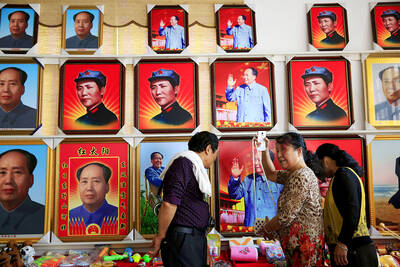
The ultimate goal of the Chinese Communist Party (CCP) is the total and overwhelming domination of everything within the sphere of what it considers China and deems as theirs. All decision-making by the CCP must be understood through that lens. Any decision made is to entrench — or ideally expand that power. They are fiercely hostile to anything that weakens or compromises their control of “China.” By design, they will stop at nothing to ensure that there is no distinction between the CCP and the Chinese nation, people, culture, civilization, religion, economy, property, military or government — they are all subsidiary
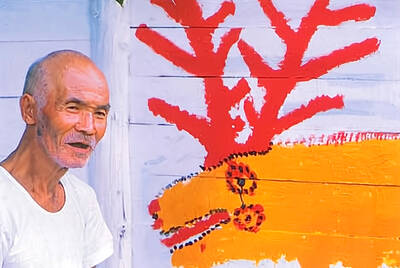
Nov.10 to Nov.16 As he moved a large stone that had fallen from a truck near his field, 65-year-old Lin Yuan (林淵) felt a sudden urge. He fetched his tools and began to carve. The recently retired farmer had been feeling restless after a lifetime of hard labor in Yuchi Township (魚池), Nantou County. His first piece, Stone Fairy Maiden (石仙姑), completed in 1977, was reportedly a representation of his late wife. This version of how Lin began his late-life art career is recorded in Nantou County historian Teng Hsiang-yang’s (鄧相揚) 2009 biography of him. His expressive work eventually caught the attention
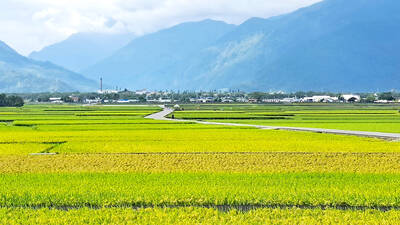
Late last month the Executive Yuan approved a proposal from the Ministry of Labor to allow the hospitality industry to recruit mid-level migrant workers. The industry, surveys said, was short 6,600 laborers. In reality, it is already heavily using illegal foreign workers — foreign wives of foreign residents who cannot work, runaways and illegally moonlighting factory workers. The proposal thus merely legalizes what already exists. The government could generate a similar legal labor supply simply by legalizing moonlighting and permitting spouses of legal residents to work legally on their current visa. But after 30 years of advocating for that reform,